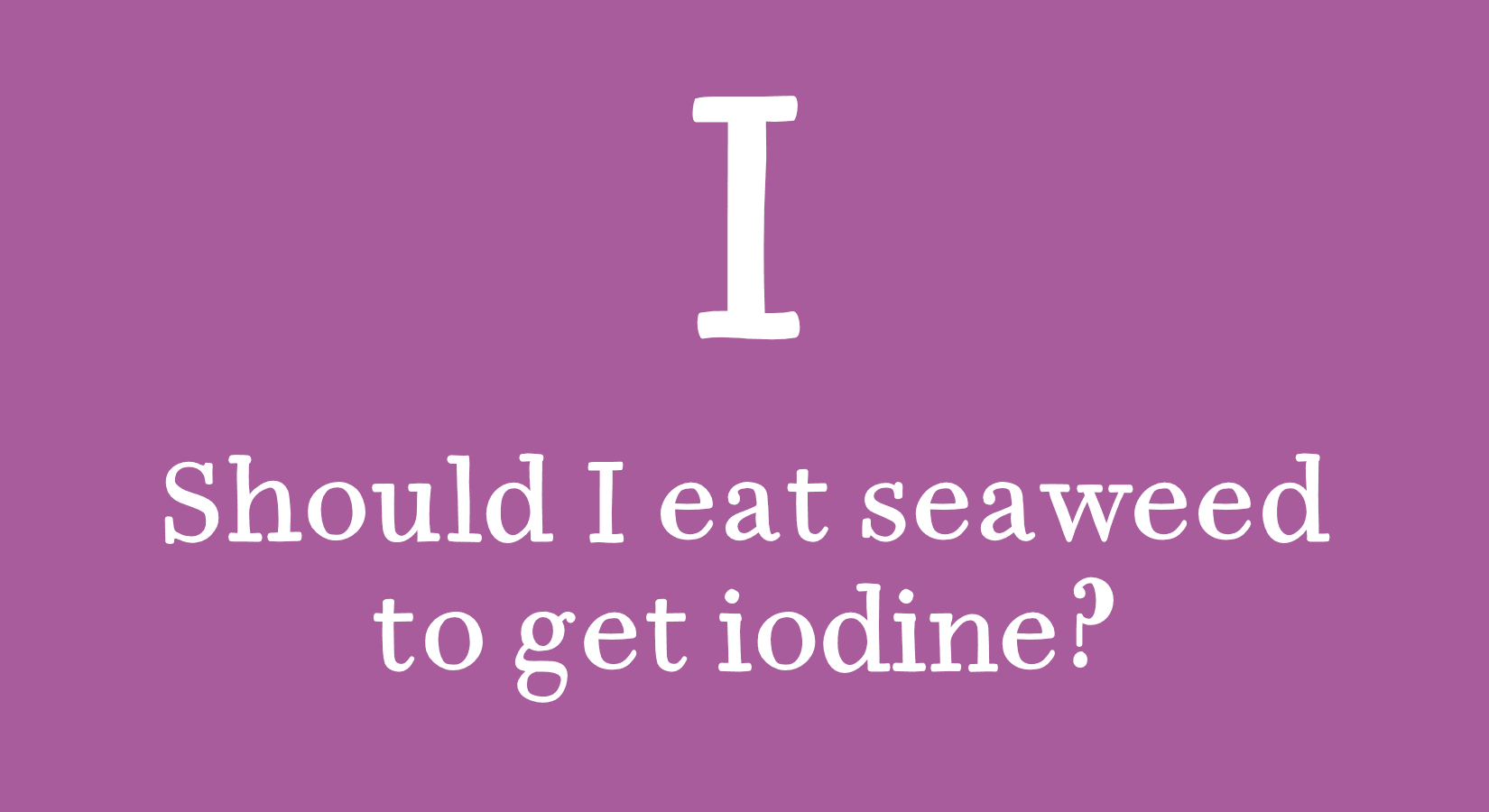People often become interested in seaweed after discovering the benefits of iodine for thyroid health, mental function, metabolism, energy levels, and protection against radiation poisoning. Adequate iodine intake optimizes all of these, and seaweed is known as one the best sources of dietary iodine there is. On the other hand, some people may avoid seaweed because they’re worried about getting too much iodine and harming their thyroid gland. So, the question is, how do we meet in the middle for a happy thyroid?
Below we tell the story of seaweed and iodine, and briefly discuss what’s known about how much iodine we should consume daily.
Why does seaweed contain so much iodine?
Iodine is not an especially abundant element. Although it’s widely distributed in crustal rock at about 46ppm on average, it’s easily washed out of agricultural soils. This means many of the foods we eat contain very little iodine. Over time, iodine has accumulated in the world’s oceans to about 58ppb (58 micrograms (µg) of iodine per liter seawater). By any standard this is a trace amount, but most seaweed species have evolved the capacity to bioaccumulate iodine from seawater to an extraordinary degree. For example, Laminaria digitata (commonly known as oarweed or horsetail kelp) is one of the strongest iodine accumulators among all living beings, concentrating it at levels 30,000 to 50,000 times higher than in the surrounding seawater.
It’s not entirely understood why or how seaweed concentrates iodine to this degree, but a prevailing theory is that iodine, which we know is antimicrobial, plays a role in plant microbial defense. Another theory is that macroalgae use iodine as an antioxidant. Both theories may be true at once.
Iodine first became known to scientists in 1811. While processing kelp to extract sodium and potassium compounds, the French chemist Bernard Courtois released a violet vapor during the extraction process that precipitated into crystals. Other scientists subsequently confirmed his suspicion that this was a new element, which was named iodide from the Greek word ioeides for violet colored.
Iodine has been associated with seaweed ever since Courtois’s fortuitous discovery. In fact, for the first 50 years of its use by people iodine was entirely sourced from seaweed. In 1865, iodine was discovered in caliche deposits (a type of sedimentary rock) found in the Atacama Desert of Chile. Today, much of the world’s iodine still comes from those deposits, as well as from oil well brine.
Iodine’s medicinal properties were quickly recognized and by 1890 at least 30 different medicines contained iodine. Iodized salt to prevent goiter, invented in 1831, was one such application. There is now a huge body of research on the essential role iodine plays in human health. However, iodine deficiency still remains a health problem in much of the world, though much less so in the developed world thanks to the use of iodized salt and a diverse diet. Interestingly, dairy products often contain iodine because it’s so widely used to disinfect cow teats during milking.
People who avoid iodized salt, dairy products, and seafood (another good source of iodine) can become iodine deficient. Others may simply want to ensure that they maintain adequate or high iodine levels. Although iodine supplements are one solution, those who prefer a more natural approach often turn to seaweed, the original iodine source. They know that in addition to iodine, seaweed contains scores of minerals, vitamins, phytochemicals, and other healthy nutrients. For such people, the question then becomes…
How much iodine is found in different seaweeds?
Seaweed iodine content ranges widely between species and even within species due to genetic and environmental factors. The data presented below represents composite averages from several sources and shouldn’t be understood as representing an exact “dose”. We’ve found that even sea vegetables harvested from the same general area, but at different times during the season, may contain different levels of iodine. The actual amount of iodine ingested in a serving of seaweed may vary by 30% or more from the average.
Fortunately, we can say some things with certainty. We know that brown seaweeds in general tend to contain more iodine than red or green seaweeds. Kombu kelp (sugar kelp) contains by far the most iodine of the brown seaweeds we sell, whereas Alaria tends to have the least amount of the browns. Red sea vegetables are intermediate between brown and green species, but dulse contains about twice as much iodine as laver and Irish moss contains just a bit less than rockweed and a bit more than Alaria. Green seaweeds from around the world generally contain the least amount of iodine. The green seaweed that we sell, sea lettuce (Ulva lactuca), contains about 4,300 micrograms per 100 grams of dried seaweed. This is close to the amount found per 100 grams in iodized salt.

How much iodine is healthy?
The recommended daily intake of iodine for a healthy adult is 150 micrograms per day, but as can be seen in the below table, the RDI varies depending on a person’s age and childbearing status. Pregnant and lactating women have the highest RDI because they have to meet their child’s needs in addition to their own. Iodine deficiency during pregnancy and lactation is considered to be the world’s leading cause of mental deficiency in children. However, pregnant or lactating woman should always consult with a medical practitioner before embarking on a new nutritional regime or taking supplements.
|
Life Stage |
Recommended Amount |
|
Birth to 6 months |
110 mcg |
|
Infants 7–12 months |
130 mcg |
|
Children 1–8 years |
90 mcg |
|
Children 9–13 years |
120 mcg |
|
Teens 14–18 years |
150 mcg |
|
Adults |
150 mcg |
|
Pregnant teens and women |
220 mcg |
|
Breastfeeding teens and women |
290 mcg |
Source: National Institutes of Health
Are you now wondering which seaweed is best to eat in order to get the right amount of iodine?
The answer is they all are, but it depends on how much you eat!
A single small serving (about 3g/1 tsp powder) of sea lettuce, our lowest iodine content sea vegetable, contributes 129 micrograms of iodine, or 86% of the RDI. However, 3 grams of sugar kelp delivers a whopping 8,163 micrograms, or 5,422% of the RDI.
Although excess iodine is unlikely to cause problems in most people when occasionally eaten, we don’t advise consuming high levels of iodine on a regular basis without first consulting a medical practitioner. The tolerable upper intake level (UL) of iodine for a healthy adult is considered to be 1,100 mcg per day. Long term intake above the UL may lead to adverse health effects, including some of the same symptoms as deficiency: goiter, elevated TSH levels, and hypothyroidism. Fortunately, these symptoms are reversible by simply reducing one’s iodine intake. Studies have also shown that excessive iodine intakes may cause thyroiditis and thyroid papillary cancer, though the risk appears low. Most healthy people easily spill excess iodine from their system, but there are those who can’t tolerate even infrequent high iodine intake.
If your primary reason for eating seaweed is to get a natural, healthy source of iodine and you want to ensure a fairly consistent and safe daily level, then your best option is to choose one of our milled varieties. Three grams of milled (powder, flakes or granules) sea lettuce, laver, dulse, Alaria, Irish moss, or bladderwrack will all deliver between 129 µg and 1,164 µg (seaweeds listed from lowest to highest iodine). Three grams is about 1-2 tsp for most forms; for more accuracy just consult the nutrition label or contact us.
If you want even more certainty we offer products that are either precisely pre-measured by us (Seaweed Support capsules) or have been lab certified by our supplier to contain a specific range of iodine (Icelandic Kelp Blend, also known as IKB). IKB is lab certified to contain 3,000 to 3,500 µg iodine per gram. If you want less iodine than that from IKB you’ll need an analytical grade balance to measure out ¼ gram (for 750 µg) or ½ gram (for 1,500 µg). A regular kitchen scale simply isn’t precise enough for measuring such small amounts.
We’re happy if iodine is what first led you to seaweed or is your primary reason for eating it. We know that for many, this reason is the gateway to discovering seaweed’s many other nutritional benefits and its versatility as a uniquely flavorful seasoning.



